Scroll through the lesson and click on notation/video/audio links to load the interactive players.
Please subscribe to get full access to all lessons for only $7.95/month PLUS 1 week free trial.

Riff Interactive lessons are
LESS expensive and
MORE interactive than alternatives!
More Info
|
|

Jazz Guitar For
Beginners
Lesson 1
Lyle: One of the most common chord change found
in Jazz is called the ii - V - I chord progression:
chord
chart

Lyle: In the chord chart above you see the Am7
for one measure (4 beats), to the D7 for one measure, to the Gmaj7 for two
measures, completing a 4 bar groove in G.
Lyle: In
the Jazz style you want to know how to play as many different minor chords in
place of the Am7, as many different D dominant chords in place of the D7, and as
many different G major type chords in place of the Gmaj7 chord on the
chart.
Lyle: Just because the chart says to play an Am7
doesn't always mean you have to play an Am7, you could replace it with an Am9 or
Am11.
Lyle: So in this lesson you will learn 7
different ways to play this little 4 bar chord progression, with countless
possibilities after that to mix it up any way you want.
Lyle: Here's a real basic way to play these
chords:
01 - ii - V - I
chords in G
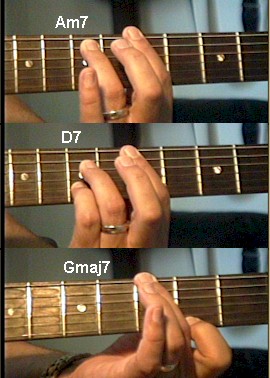
Lyle:
Now try playing these along to this jam track. Strum once for each chord on beat
1 of each measure. Let the Gmaj7 chord ring out for the 4th measure. Make it
sound like me from the video clip above. Here's the link to your jam track:
chord
chart

Lyle: Now try a new way to play these chords.
This time you'll substitute a D9 chord in place of the D7 for more
"color".
02 - ii - V - I
chords in G
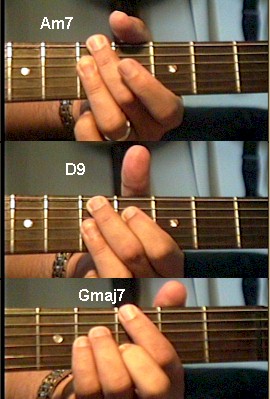
Lyle:
Not all chords use all 6 strings. You'll need to get good at muting the strings
that are not being used.
Skedman: That is tough.
David:
Muting? By barely pressing the 5th string with your 1st finger so it doesn't
play?
Lyle: Muting is by touching the string with the
skin of a finger, not pressing on it, but just slightly touching
it.
Lyle:
The next version replaces the Am7 with Am11, the D7 is replaced with a D7b5 and
the Gmaj7 stays the same. Notice you're getting much more harmonic structure
from playing these fancy chords rather than playing just the plain Am7
etc.
03 - ii - V - I
chords in G
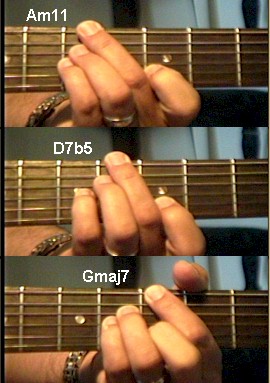
TomH: Many of
the notes are the same between those
chords.
Lyle: That is correct. It keeps the harmonic
shift close, so they all blend nicely
TomH: "harmonic shift", I'll add that to my vocabulary
:)
Lyle:
It's cool to find common tones of chords or at least half step
shifts. Like in this next example, the 1st string
has a descending melody of half steps:
04 - ii - V - I
chords in G
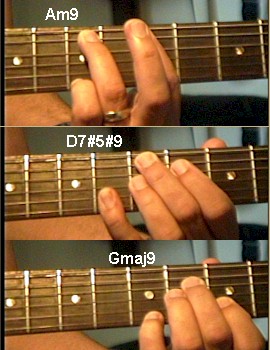
Skedman: This
is great Lyle. Very inspiring. I need a fresh approach to my rhythm
playing.
Lyle: I work on rhythm ideas in upcoming
lessons.
Lyle: Let's jump up the neck and look at a common
way to play these chords up high:
05 - ii - V - I
chords in G
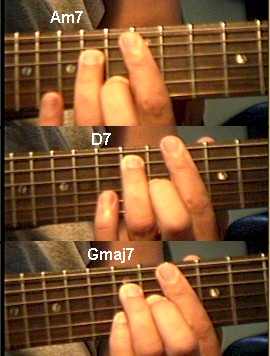
Lyle:
These might be the ones you would normally finger.
These should sound very
"common" as far as their harmonic structure goes.
Lyle:
Substitute the Am7 with Am9, sub the D7 with a D7#5, and sub the Gmaj7 with a
Gmaj9 and you've got a richer sounding chord progression:
06 - ii - V - I
chords in G

Lyle:
Here's one more way to play these. This one starts with a cool version of the
Am7, then D13 in place of the D7, then a G6/9 chord which is a major chord in
place of the Gmaj7:
07 - ii - V - I
chords in G
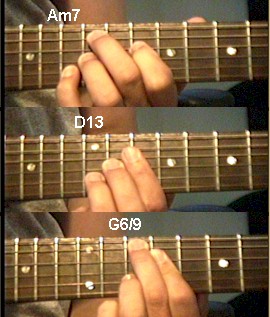
Lyle:
Memorize as many of the chords and their names that you can from this
lesson.
Lyle: In the lesson sample from the top of this
lesson I played all 7 of these chord examples in order just like you
learned.
Lyle: I had to write them down in a way that I
could remember what version of each chord I was going to play
next.
Lyle: Each one of these examples gives you a new
sound and something cooler to play other than what the chord chart asks you to
play.
Skedman:
Can you transcribe the lead in the
example?
pacer:
So can you mix them up, the chords?
Lyle: Yes, you can mix up the different chords,
any of the minor chords can be used in place of the Am7, any of the D dominant
chords in place of the D7, and any of the G major chord variations in place of
the Gmaj7. The lead in the example is made from the G major
scale:
Lyle:
Here's the little lead solo from the lesson sample:
Skedman: Thanks. Kinda sounds like Spongebob
music.
Lyle: Reminds me of Mr. Ed the talking
horse.
Skedman:
Yeah that too, lol.
Lyle: That's all for this lesson. You have a lot
to study. You'll be tested on it next week!
|
<< load notation from left
|
|
<< load audio from left
|
<< load audio from left
|